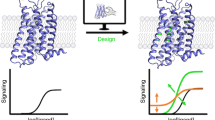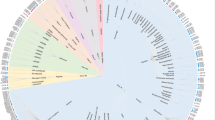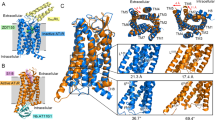Abstract
The drug discovery landscape has been transformed over the past decade by the discovery of allosteric modulators of all major mammalian receptor superfamilies. Allosteric ligands are a rich potential source of drugs and drug targets with clear therapeutic advantages. G protein–coupled receptors, ligand-gated ion channels and intracellular nuclear hormone receptors have all been targeted by allosteric modulators. More recently, a receptor tyrosine kinase (RTK) has been targeted by an extracellular small-molecule allosteric modulator. Allosteric mechanisms of structurally distinct molecules that target the various receptor families are more alike than originally anticipated and include selectivity, orthosteric probe dependence and pathway-biased signaling.
This is a preview of subscription content, access via your institution
Access options
Subscribe to this journal
Receive 12 print issues and online access
$209.00 per year
only $17.42 per issue
Buy this article
- Purchase on Springer Link
- Instant access to full article PDF
Prices may be subject to local taxes which are calculated during checkout





Similar content being viewed by others
References
Hopkins, A.L. & Groom, C.R. The druggable genome. Nat. Rev. Drug Discov. 1, 727–730 (2002).
Overington, J.P., Al-Lazikani, B. & Hopkins, A.L. How many drug targets are there? Nat. Rev. Drug Discov. 5, 993–996 (2006).
Lundstrom, K. An overview on GPCRs and drug discovery: structure-based drug design and structural biology on GPCRs. Methods Mol. Biol. 552, 51–66 (2009).
Neubig, R.R., Spedding, M., Kenakin, T. & Christopoulos, A. International Union of Pharmacology Committee on Receptor Nomenclature and Drug Classification. XXXVIII. Update on terms and symbols in quantitative pharmacology. Pharmacol. Rev. 55, 597–606 (2003).
Wootten, D., Christopoulos, A. & Sexton, P.M. Emerging paradigms in GPCR allostery: implications for drug discovery. Nat. Rev. Drug Discov. 12, 630–644 (2013).
Kenakin, T. & Christopoulos, A. Signalling bias in new drug discovery: detection, quantification and therapeutic impact. Nat. Rev. Drug Discov. 12, 205–216 (2013).
Christopoulos, A. Allosteric binding sites on cell-surface receptors: novel targets for drug discovery. Nat. Rev. Drug Discov. 1, 198–210 (2002).
Conn, P.J., Christopoulos, A. & Lindsley, C.W. Allosteric modulators of GPCRs: a novel approach for the treatment of CNS disorders. Nat. Rev. Drug Discov. 8, 41–54 (2009).
De Amici, M., Dallanoce, C., Holzgrabe, U., Trankle, C. & Mohr, K. Allosteric ligands for G protein-coupled receptors: a novel strategy with attractive therapeutic opportunities. Med. Res. Rev. 30, 463–549 (2010).
Moore, T.W., Mayne, C.G. & Katzenellenbogen, J.A. Minireview: Not picking pockets: nuclear receptor alternate-site modulators (NRAMs). Mol. Endocrinol. 24, 683–695 (2010).
Bono, F. et al. Inhibition of tumor angiogenesis and growth by a small-molecule multi-FGF receptor blocker with allosteric properties. Cancer Cell 23, 477–488 (2013).
Herbert, C. et al. Molecular mechanism of SSR128129E, an extracellularly acting, small-molecule, allosteric inhibitor of FGF receptor signaling. Cancer Cell 23, 489–501 (2013).
Melancon, B.J. et al. Allosteric modulation of seven transmembrane spanning receptors: theory, practice, and opportunities for central nervous system drug discovery. J. Med. Chem. 55, 1445–1464 (2012).
McEwan, I.J. Nuclear hormone receptors: allosteric switches. Mol. Cell. Endocrinol. 348, 345–347 (2012).
Estébanez-Perpiñá, E. et al. A surface on the androgen receptor that allosterically regulates coactivator binding. Proc. Natl. Acad. Sci. USA 104, 16074–16079 (2007).
Birdsall, N.J. & Lazareno, S. Allosterism at muscarinic receptors: ligands and mechanisms. Mini Rev. Med. Chem. 5, 523–543 (2005).
Lemmon, M.A. & Schlessinger, J. Cell signaling by receptor tyrosine kinases. Cell 141, 1117–1134 (2010).
O′Hayre, M. et al. The emerging mutational landscape of G proteins and G-protein-coupled receptors in cancer. Nat. Rev. Cancer 13, 412–424 (2013).
Shah, D.R., Shah, R.R. & Morganroth, J. Tyrosine kinase inhibitors: their on-target toxicities as potential indicators of efficacy. Drug Safety 36, 413–426 (2013).
He, K. et al. Blockade of glioma proliferation through allosteric inhibition of JAK2. Sci. Signal. 6, ra55 (2013).
Zhang, J., Yang, P.L. & Gray, N.S. Targeting cancer with small molecule kinase inhibitors. Nat. Rev. Cancer 9, 28–39 (2009).
Grebien, F. et al. Targeting the SH2-kinase interface in Bcr-Abl inhibits leukemogenesis. Cell 147, 306–319 (2011).
Hantschel, O., Grebien, F. & Superti-Furga, G. The growing arsenal of ATP-competitive and allosteric inhibitors of BCR-ABL. Cancer Res. 72, 4890–4895 (2012).
Zhang, J. et al. Targeting Bcr-Abl by combining allosteric with ATP-binding-site inhibitors. Nature 463, 501–506 (2010).
Gui, D.Y., Lewis, C.A. & Vander Heiden, M.G. Allosteric regulation of PKM2 allows cellular adaptation to different physiological states. Sci. Signal. 6, pe7 (2013).
Chaneton, B. et al. Serine is a natural ligand and allosteric activator of pyruvate kinase M2. Nature 491, 458–462 (2012).
Cherrin, C. et al. An allosteric Akt inhibitor effectively blocks Akt signaling and tumor growth with only transient effects on glucose and insulin levels in vivo. Cancer Biol. Ther. 9, 493–503 (2010).
Burke, J.R. et al. BMS-345541 is a highly selective inhibitor of I kappa B kinase that binds at an allosteric site of the enzyme and blocks NF-kappa B-dependent transcription in mice. J. Biol. Chem. 278, 1450–1456 (2003).
Leonard, T.A., Rozycki, B., Saidi, L.F., Hummer, G. & Hurley, J.H. Crystal structure and allosteric activation of protein kinase C betaII. Cell 144, 55–66 (2011).
Karaman, M.W. et al. A quantitative analysis of kinase inhibitor selectivity. Nat. Biotechnol. 26, 127–132 (2008).
Suárez, R.M. et al. Inhibitors of the TAM subfamily of tyrosine kinases: synthesis and biological evaluation. Eur. J. Med. Chem. 61, 2–25 (2013).
Yang, Y., Yuzawa, S. & Schlessinger, J. Contacts between membrane proximal regions of the PDGF receptor ectodomain are required for receptor activation but not for receptor dimerization. Proc. Natl. Acad. Sci. USA 105, 7681–7686 (2008).
Hyde, C.A. et al. Targeting extracellular domains D4 and D7 of vascular endothelial growth factor receptor 2 reveals allosteric receptor regulatory sites. Mol. Cell. Biol. 32, 3802–3813 (2012).
Yang, Y., Xie, P., Opatowsky, Y. & Schlessinger, J. Direct contacts between extracellular membrane-proximal domains are required for VEGF receptor activation and cell signaling. Proc. Natl. Acad. Sci. USA 107, 1906–1911 (2010).
Laine, E., Auclair, C. & Tchertanov, L. Allosteric communication across the native and mutated KIT receptor tyrosine kinase. PLoS Comput. Biol. 8, e1002661 (2012).
Leppänen, V.M. et al. Structural and mechanistic insights into VEGF receptor 3 ligand binding and activation. Proc. Natl. Acad. Sci. USA 110, 12960–12965 (2013).
Macdonald-Obermann, J.L. & Pike, L.J. The intracellular juxtamembrane domain of the epidermal growth factor (EGF) receptor is responsible for the allosteric regulation of EGF binding. J. Biol. Chem. 284, 13570–13576 (2009).
Thiel, K.W. & Carpenter, G. Epidermal growth factor receptor juxtamembrane region regulates allosteric tyrosine kinase activation. Proc. Natl. Acad. Sci. USA 104, 19238–19243 (2007).
Li, E. & Hristova, K. Receptor tyrosine kinase transmembrane domains: Function, dimer structure and dimerization energetics. Cell Adh. Migr. 4, 249–254 (2010).
Jang, S.W. et al. Gambogic amide, a selective agonist for TrkA receptor that possesses robust neurotrophic activity, prevents neuronal cell death. Proc. Natl. Acad. Sci. USA 104, 16329–16334 (2007).
Cazorla, M. et al. Cyclotraxin-B, the first highly potent and selective TrkB inhibitor, has anxiolytic properties in mice. PLoS ONE 5, e9777 (2010).
Udugamasooriya, D.G., Dineen, S.P., Brekken, R.A. & Kodadek, T. A peptoid “antibody surrogate” that antagonizes VEGF receptor 2 activity. J. Am. Chem. Soc. 130, 5744–5752 (2008).
Endres, N.F., Engel, K., Das, R., Kovacs, E. & Kuriyan, J. Regulation of the catalytic activity of the EGF receptor. Curr. Opin. Struct. Biol. 21, 777–784 (2011).
Fleishman, S.J., Schlessinger, J. & Ben-Tal, N. A putative molecular-activation switch in the transmembrane domain of erbB2. Proc. Natl. Acad. Sci. USA 99, 15937–15940 (2002).
Leahy, D.J. A molecular view of anti-ErbB monoclonal antibody therapy. Cancer Cell 13, 291–293 (2008).
Jura, N. et al. Catalytic control in the EGF receptor and its connection to general kinase regulatory mechanisms. Mol. Cell 42, 9–22 (2011).
Tvorogov, D. et al. Effective suppression of vascular network formation by combination of antibodies blocking VEGFR ligand binding and receptor dimerization. Cancer Cell 18, 630–640 (2010).
Jaffe, E.K. Impact of quaternary structure dynamics on allosteric drug discovery. Curr. Top. Med. Chem. 13, 55–63 (2013).
Grünewald, F.S., Prota, A.E., Giese, A. & Ballmer-Hofer, K. Structure-function analysis of VEGF receptor activation and the role of coreceptors in angiogenic signaling. Biochim. Biophys. Acta 1804, 567–580 (2010).
Murakami, M., Elfenbein, A. & Simons, M. Non-canonical fibroblast growth factor signalling in angiogenesis. Cardiovasc. Res. 78, 223–231 (2008).
Weisheit, S., Schafer, C., Mertens, C., Berndt, A. & Liebmann, C. PKCepsilon acts as negative allosteric modulator of EGF receptor signalling. Cell. Signal. 23, 436–448 (2011).
Weisheit, S. & Liebmann, C. Allosteric modulation by protein kinase Cepsilon leads to modified responses of EGF receptor towards tyrosine kinase inhibitors. Cell. Signal. 24, 422–434 (2012).
Landgraf, K.E. et al. Allosteric peptide activators of pro-hepatocyte growth factor stimulate Met signaling. J. Biol. Chem. 285, 40362–40372 (2010).
Perron, M. et al. Allosteric non-competitive small molecule selective inhibitors of CD45 tyrosine phosphatase suppress T-cell receptor signals and inflammation in vivo. Mol. Pharmacol. 85, 553–563 (2014).
Hardy, J.A. & Wells, J.A. Searching for new allosteric sites in enzymes. Curr. Opin. Struct. Biol. 14, 706–715 (2004).
Lebakken, C.S., Reichling, L.J., Ellefson, J.M. & Riddle, S.M. Detection of allosteric kinase inhibitors by displacement of active site probes. J. Biomol. Screen. 17, 813–821 (2012).
Yang, J.S., Seo, S.W., Jang, S., Jung, G.Y. & Kim, S. Rational engineering of enzyme allosteric regulation through sequence evolution analysis. PLoS Comput. Biol. 8, e1002612 (2012).
Corbin, J.A. et al. Improved glucose metabolism in vitro and in vivo by an allosteric monoclonal antibody that increases insulin receptor binding affinity. PLoS ONE 9, e88684 (2014).
Lee, S., Jilani, S.M., Nikolova, G.V., Carpizo, D. & Iruela-Arispe, M.L. Processing of VEGF-A by matrix metalloproteinases regulates bioavailability and vascular patterning in tumors. J. Cell Biol. 169, 681–691 (2005).
McTigue, M. et al. Molecular conformations, interactions, and properties associated with drug efficiency and clinical performance among VEGFR TK inhibitors. Proc. Natl. Acad. Sci. USA 109, 18281–18289 (2012).
Acknowledgements
F.D.S. is supported by the Fund for Scientific Research (FWO), Flanders. A.C. is a principal research fellow of the National Health and Medical Research Council of Australia. This work is supported by grant #G.0789.11 and #G.00764.10 from the FWO, Belgium; the Belgian Science Policy (IAP #P7/03); Leducq Network of Excellence; and long-term structural Methusalem funding by the Flemish Government to P.C.
Author information
Authors and Affiliations
Corresponding author
Ethics declarations
Competing interests
Peter Carmeliet and Frederik De Smet declare to be named as inventors on patent applications, claiming subject matter related to the results described in this paper.
Arthur Christopoulous has no competing interest with regards to this review article.
Rights and permissions
About this article
Cite this article
De Smet, F., Christopoulos, A. & Carmeliet, P. Allosteric targeting of receptor tyrosine kinases. Nat Biotechnol 32, 1113–1120 (2014). https://doi.org/10.1038/nbt.3028
Published:
Issue Date:
DOI: https://doi.org/10.1038/nbt.3028
This article is cited by
-
Functionally selective signaling and broad metabolic benefits by novel insulin receptor partial agonists
Nature Communications (2022)
-
Inhibition of neuronal FLT3 receptor tyrosine kinase alleviates peripheral neuropathic pain in mice
Nature Communications (2018)
-
HTS-compatible FRET-based conformational sensors clarify membrane receptor activation
Nature Chemical Biology (2017)
-
Orthosteric- versus allosteric-dependent activation of the GABAA receptor requires numerically distinct subunit level rearrangements
Scientific Reports (2017)
-
Allosteric activation of membrane-bound glutamate receptors using coordination chemistry within living cells
Nature Chemistry (2016)



